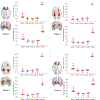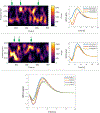Dynamic variations of resting-state BOLD signal spectra in white matter
- PMID: 35131432
- PMCID: PMC8915948
- DOI: 10.1016/j.neuroimage.2022.118972
Dynamic variations of resting-state BOLD signal spectra in white matter
Abstract
Recent studies have demonstrated that the mathematical model used for analyzing and interpreting fMRI data in gray matter (GM) is inappropriate for detecting or describing blood-oxygenation-level-dependent (BOLD) signals in white matter (WM). In particular the hemodynamic response function (HRF) which serves as the regressor in general linear models is different in WM compared to GM. We recently reported measurements of the frequency contents of resting-state signal time courses in WM that showed distinct power spectra which depended on local structural-vascular-functional associations. In addition, multiple studies of GM have revealed how functional connectivity between regions, as measured by the correlation between BOLD time series, varies dynamically over time. We therefore investigated whether and how BOLD signals from WM in a resting state varied over time. We measured voxel-wise spectrograms, which reflect the time-varying spectral patterns of WM time courses. The results suggest that the spectral patterns are non-stationary but could be categorized into five modes that recurred over time. These modes showed distinct spatial distributions of their occurrences and durations, and the distributions were highly consistent across individuals. In addition, one of the modes exhibited a strong coupling of its occurrence between GM and WM across individuals, and two communities of WM voxels were identified according to the hierarchical structures of transitions among modes. Moreover, these modes are coupled to the shape of instantaneous HRFs. Our findings extend previous studies and reveal the non-stationary nature of spectral patterns of BOLD signals over time, providing a spatial-temporal-frequency characterization of resting-state signals in WM.
Keywords: Dynamic; Hemodynamic response function; Power spectra; Resting state; White matter; fMRI.
Copyright © 2022 The Author(s). Published by Elsevier Inc. All rights reserved.
Conflict of interest statement
Declaration of Competing Interest We declare no conflict of interest
Figures







Similar articles
-
Functional MRI and resting state connectivity in white matter - a mini-review.Magn Reson Imaging. 2019 Nov;63:1-11. doi: 10.1016/j.mri.2019.07.017. Epub 2019 Jul 31. Magn Reson Imaging. 2019. PMID: 31376477 Free PMC article. Review.
-
Extraction of dynamic functional connectivity from brain grey matter and white matter for MCI classification.Hum Brain Mapp. 2017 Oct;38(10):5019-5034. doi: 10.1002/hbm.23711. Epub 2017 Jun 30. Hum Brain Mapp. 2017. PMID: 28665045 Free PMC article.
-
Detection of functional activity in brain white matter using fiber architecture informed synchrony mapping.Neuroimage. 2022 Sep;258:119399. doi: 10.1016/j.neuroimage.2022.119399. Epub 2022 Jun 18. Neuroimage. 2022. PMID: 35724855 Free PMC article.
-
Power spectra reveal distinct BOLD resting-state time courses in white matter.Proc Natl Acad Sci U S A. 2021 Nov 2;118(44):e2103104118. doi: 10.1073/pnas.2103104118. Proc Natl Acad Sci U S A. 2021. PMID: 34716261 Free PMC article.
-
Biophysical and neural basis of resting state functional connectivity: Evidence from non-human primates.Magn Reson Imaging. 2017 Jun;39:71-81. doi: 10.1016/j.mri.2017.01.020. Epub 2017 Feb 2. Magn Reson Imaging. 2017. PMID: 28161319 Free PMC article. Review.
Cited by
-
A method for capturing dynamic spectral coupling in resting fMRI reveals domain-specific patterns in schizophrenia.Front Neurosci. 2023 Apr 27;17:1078995. doi: 10.3389/fnins.2023.1078995. eCollection 2023. Front Neurosci. 2023. PMID: 37179560 Free PMC article.
-
Cerebrovascular reactivity mapping using breath-hold BOLD-fMRI: Comparison of signal models combined with voxelwise lag optimization.Imaging Neurosci (Camb). 2025 Jul 14;3:IMAG.a.80. doi: 10.1162/IMAG.a.80. eCollection 2025. Imaging Neurosci (Camb). 2025. PMID: 40800828 Free PMC article.
-
Evaluation of cerebrovascular reactivity in moyamoya disease using oxygen-dependent magnetic resonance imaging.iScience. 2024 Jan 19;27(2):108923. doi: 10.1016/j.isci.2024.108923. eCollection 2024 Feb 16. iScience. 2024. PMID: 38323000 Free PMC article.
-
Changes in white matter functional networks across late adulthood.Front Aging Neurosci. 2023 Jun 30;15:1204301. doi: 10.3389/fnagi.2023.1204301. eCollection 2023. Front Aging Neurosci. 2023. PMID: 37455933 Free PMC article.
-
Alpha-frequency stimulation strengthens coupling between temporal fluctuations in alpha oscillation power and default mode network connectivity.eNeuro. 2025 Mar 11;12(3):ENEURO.0449-24.2025. doi: 10.1523/ENEURO.0449-24.2025. Online ahead of print. eNeuro. 2025. PMID: 40068873 Free PMC article.
References
Publication types
MeSH terms
Grants and funding
LinkOut - more resources
Full Text Sources
Medical

